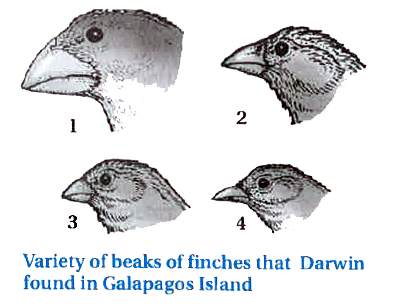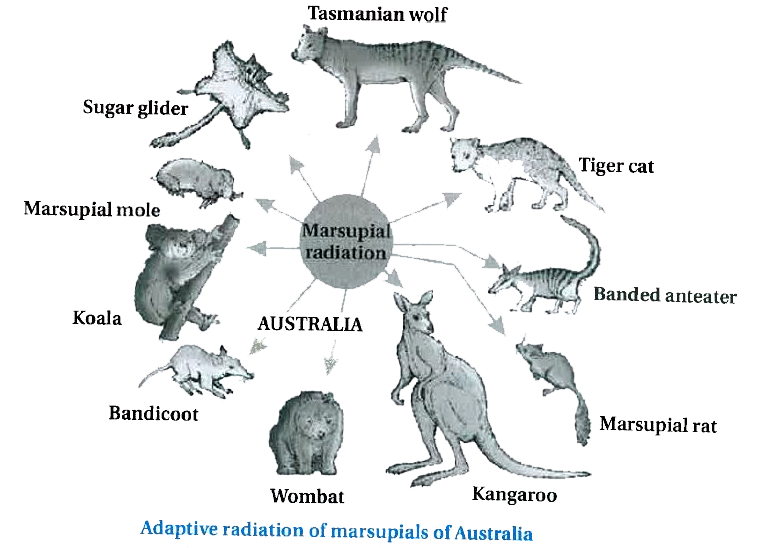Marsupials and Australian placental mammals exhibit convergent evolution. Explain how?
Text Solution
Adaptive Radiation : The process of evolution of different species starting from a point ih a geographical area and finally radiating to other area of geography (habitats) is called adaptive radiation.

Example of adaption radiation are :
(i) Darwin.s Finches: Darwin observed an amazing diversity of creatures in Galapagos island.
There he saw the small black birds that amazed him the most later called as Darwin finches. Koala
They represent one of the best examples of adaptive radiation.
He observed that there were many varieties of finches in the same island and all the varieties have evolved on the island itself from original seed eating finches.
He explained that after originating from a common ancestral seed eating stock the finches must have radiated to different geographical areas and under gene adaptive changes, especially in the type of beaks.
Therefore, due to the alterations in beaks gradually, some become insectivorous and some vegetarian.
Living in isolation for long the new kind of finches emerged that could function and survive in new habitat.
(ii) Marsupials of Australia : These are another example of adaptive radiation.

A variety of marsupials (pouched mammals) each different from the other, evolved from an ancestral stock, but all within the Australian island continent.
(iii) Adaptive convergence I convergent Evolution: When more than one adaptive radiation appeared to have occurred in an isolated geographical area (representing different habitats)
and two or more groups of unrelated animals come to resembles each other for similar mode of life or habitat it is called adaptive convergence or convergent evolution.
(iv) Adaptive convergence in mammals : Australia marsupials and placental mammals in North America provide another example of convergent evolution.
Despite the temporal and geographical separation, Marsupials in Australia and placental mammals in North America have produced varieties of species living in similar habitat with similar ways of living.

They are not related but resemble each other because they fill similar niches in each continent.
e.g. placental wolf and Tasmanian wolf marsupial.
|
Topper's Solved these Questions
- EVOLUTIONBOOK - KUMAR PRAKASHANCHAPTER - EVOLUTIONEXERCISE - SECTION - B (Difference / Scientific Reasons) (Give differences)
2 Videos
- EVOLUTIONBOOK - KUMAR PRAKASHANCHAPTER - EVOLUTIONEXERCISE - SECTION - B (Difference / Scientific Reasons) (Give scientific reasons)
2 Videos
- ENVIRONMENTAL ISSUESBOOK - KUMAR PRAKASHANCHAPTER - ENVIRONMENTAL ISSUESEXERCISE - Section - F (Multiple Choice Question (MCQs))(MCQs ASKED IN COMPETITIVE EXAM)
22 Videos
- HUMAN HEALTH AND DISEASE BOOK - KUMAR PRAKASHANCHAPTER - HUMAN HEALTH AND DISEASE EXERCISE - Section - F (Multiple Choice Question) (MCQs Asked In Competitive Exam))
33 Videos
Similar Questions
Knowledge Check
Convergent evolution is shown by
Ahomologous organsBaonlogous organsCvestigial organsDAll of theseConvergent evolution is shown by :
Arabbit and dogBstarfish and jellyfishCfish and whaleDbacteria and AmoebaEggs of placental mammals are
AHomolecithalBAlecithalCMicrolecithalDMesolecithal.
Define divergent and convergent evolution.
View SolutionWhich of the following is not exhibiting convergent evolution ?
View SolutionWhich of the following is not exhibiting convergent evolution ?
View SolutionParallel evolution of marsupials in Australian region and placentals in other parts of the world shows that
View SolutionUnlike placental mammals, both monotremes and marsupials:
View Solution
